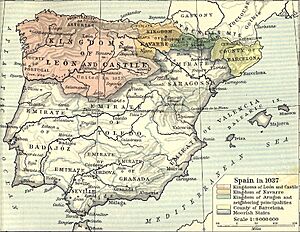Gonzalo of Sobrarbe and Ribagorza facts for kids
Gonzalo Sánchez (c. 1020 – June 26, 1043) was a king of two small regions called Sobrarbe and Ribagorza. These areas were located in the Pyrenees mountains. He ruled from 1035 until his death.
Gonzalo was the son of King Sancho III of Navarre and his wife, Muniadona of Castile. Before King Sancho III died in 1035, he divided his kingdom among his sons. Gonzalo received Sobrarbe and Ribagorza. He ruled these lands as a vassal (a ruler who owes loyalty to a more powerful king) to his older brother, García Sánchez III. García had inherited the main kingdom of Navarre.
Some historians believe Gonzalo was not a very effective or popular ruler. It is thought that some of his nobles even switched their loyalty to his half-brother, Ramiro I of Aragon, while Gonzalo was still alive. Within ten years of his death, people began to forget his reign. He was even left out of lists of rulers for Ribagorza.
Becoming King
On April 14, 1035, King Sancho III gave the region of Aragon to his oldest son, Ramiro. This was recorded in a document from the monastery of San Juan de la Peña. In the same document, the castle of Loarre and the San Emeterio monastery were separated from Aragon. They were given to Gonzalo as part of his inheritance.
There is no sign that Gonzalo and his brothers had any disagreements. Gonzalo often approved important documents alongside his brothers. They frequently appeared together in official records.
Family Meetings
Gonzalo was present with all his brothers and his brother-in-law, King Vermudo III of León, on August 22, 1036. This was when Ramiro gave a special gift, called arras, to his future wife, Ermesinda of Bigorre. In the document recording this gift, Gonzalo is called a king.
In 1037, Gonzalo joined his brothers García and Ramiro to confirm a gift. This gift was made by Jimeno Garcés, who was Ramiro's godfather, to the monastery of Leire. In this document, García used the title princeps, which means "foremost" or "prince." This showed that he was the most important ruler among his brothers. Ramiro and Gonzalo used the title regulus, which means "petty king" or "small king."
This meeting likely happened at Leire or in García's capital city, Pamplona. The exact day and month are not known. Using a royal title, even a smaller one like regulus, while his more powerful brother García was present, suggests something important. It shows that King Sancho III probably intended for Gonzalo and Ramiro to rule their own kingdoms.
Gonzalo also met with all his brothers, including the youngest, Ferdinand, in Anzánigo. This meeting happened in 1037, or possibly as late as 1043. It took place after Ferdinand had become the king of León.
His Death
Gonzalo died on June 26. This date is written in the records of the Sobrarbe monastery of San Victorián. However, the exact year of his death was not recorded there, which has caused much discussion among historians.
Some early historians thought he died in 1035. Others suggested 1042 or 1043. A later book, the Chronicle of San Juan de la Peña, says he died in 1037. But there is a document from September 1039 that Gonzalo confirmed. This makes 1037 unlikely.
It seems Gonzalo was dead by September 1040. This is because Ramiro confirmed the rights of the Bishops of Urgell in Ribagorza that month. Historians now generally agree he died between late 1039 and late 1040, or possibly in 1043.
The Chronicle of San Juan de la Peña states that Gonzalo was killed by one of his own knights, Ramonat de Uasconya. The knight reportedly threw him from a bridge over the river Esera at Montclús, near Lascorz. Gonzalo was buried in the monastery of San Victorián. After his death, his brother García gave Gonzalo's lands to Ramiro.
Gonzalo did not have any children. His short time as king was quickly forgotten by many. Later historical writings often did not even mention him when talking about how Sancho III's kingdom was divided.
 In Spanish: Gonzalo I de Sobrarbe y Ribagorza para niños
In Spanish: Gonzalo I de Sobrarbe y Ribagorza para niños


